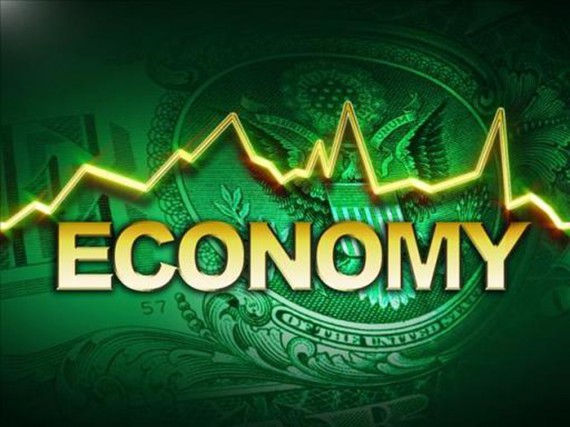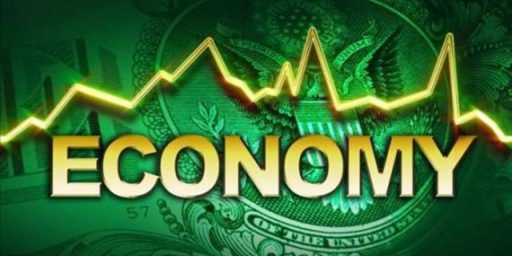Final Revision Shows Strong Second Quarter GDP Growth
The final GDP revision for the second quarter showed the economy grew at a nearly four percent rate.
The final revision to Gross Domestic Product for the second quarter of the year showed that the economy expanded at an annualized rate of nearly four percent, which is likely to revive debates over the direction of Federal Reserve Board policy:
WASHINGTON — The U.S. economy expanded more than previously estimated in the second quarter on stronger consumer spending and construction, backing the case for an interest rate rise before the end of the year despite data sounding a note of caution for September.
The Commerce Department said on Friday gross domestic product rose at a 3.9 percent annual pace in the April-June quarter, up from the 3.7 percent pace reported last month.
The data supports the case that the U.S. economy may be gaining enough strength to withstand an increase in benchmark interest rates from record low levels despite growing concerns about the global economy.
Still, many economists are expecting a cooler pace of growth in the third quarter, a view bolstered by separate data showing slower growth in services and a drop in consumer sentiment in September.
The U.S. Federal Reserve last week held off on hiking rates, but Fed Chair Janet Yellen kept the door open to an increase this year in a speech on Thursday night, as long as inflation remains stable and growth is strong enough to boost employment.
“There are a lot of things to like about the domestic side of the economy for the second half of the year despite all the global malaise,” said Jacob Oubina, senior economist at RBC Capital Markets in New York. “If the domestic economy holds in there, (Fed policymakers) are going to hike in December.”
Second-quarter growth, which beat expectations in a Reuters poll for the third GDP reading to be unchanged at 3.7 percent, was bolstered by higher consumer spending, mainly on services like healthcare and transport.
Treasury debt prices extended losses and the dollar hit a fresh five-week high against a basket of currencies on the second-quarter figures, although U.S. stock index futures pared some gains after the September data was released.
(…)
But the stronger consumer spending and a smaller inventory build reported for the second quarter are a good sign for growth in the July-September period.
Consumer spending, which accounts for more than two thirds of U.S. economic activity, was revised up to a 3.6 percent growth pace from the 3.1 percent rate reported in August, helped by cheap gasoline prices and relatively higher house prices boosting household wealth.
Revised construction spending data helped to push up the headline figure, with non-residential fixed investment expanding 4.1 percent in the quarter. Business investment on structures was revised upwards along with residential fixed investment.
The revisions to second-quarter growth also reflected a smaller accumulation of inventories than earlier estimated, reducing the chance that a sharp unwinding in inventories would drag on growth.
“For the Fed, the forward-looking part is most important and the one positive take-away is inventory contribution,” said Gennadiy Goldberg, interest rates strategist at TD Securities.
“There had been quite a bit of fear that strong inventory building in Q2 would be unwound in Q3. It actually shows GDP should be a little firmer in the next quarter, but not by a whole lot.”
Last month’s revision to the second quarter growth figures showed the economy growing at a 3.7%. While this was better than the initial forecast of 2.3% growth, and certainly better than the essentially negative growth we saw in the first three months of the year, there were still several signs of concern that led analysts to believe that the economy was not as strong as it seemed heading into the rest of the year. For one thing, the August report showed heavy inventory buildup but little indication of increased economic activity elsewhere in the economy, especially on the consumer spending side. Ordinarily, that would be an indication that the growth reported was not sustainable since inventory growth is something that doesn’t tend to be repeated from quarter to quarter. Instead, to keep the economy growing after a period of sustained inventory growth you need spending by consumers and businesses that helps to draw down that inventory. Additionally, the jobs reports for both July and August seemed to indicate that the economy was far weaker than it appeared to be. Finally, financial instability in China that spread to Wall Street, along with a European economy that is still slow seven years after the 2008 financial crisis and a recession in Canada, led many analysts to believe that the economy here in the U.S. was vulnerable to shocks from elsewhere in the world.
Hanging over all of this, was the Federal Reserve Board. For months, the Fed had been hinting that it was begin raising interest rates from the historically low levels they have been at since the financial crisis. Over the summer, the board began telegraphing that this increase would likely come in September. However, when that September date rolled around and the board had been digesting a summer’s worth of cautionary news, including the last GDP revision, they ended up deciding to keep interest rates where they are for the time being. With this latest report indicating that second quarter growth was more broad based than originally thought, it’s likely that we’ll see a renewal of speculation regarding an interesting rate hike, although it’s worth noting that Wall Street doesn’t seem to be too worried about that happening in the immediate future. Notwithstanding Wall Street’s optimism today, if the initial statistics about the third quarter economy that we’ll see over the next month show numbers similar to what we see here, then you can expect to see Janet Yellin and others hinting yet again that rates will go up before the end of the year.




We have to keep an eye on the world economy. The VW ( and perhaps other German automakers) scandal will result in a potentially big hit on the German economy. It appears the Chinese is economy is in a slow downward spiral. The Candian economy is in trouble because of reduced energy prices. All of this will have an impact on the US economy
So the initial number was basically half the final number? Why are we still paying attention to that number? I mean, I know economics is voodoo and chicken entrails at the best of times, but why are we focusing on a number that is so often wrong?
Here…let me type what the world’s greatest business-man will type…because he has been typing the same thing for years…and doesn’t seem concerned with the fact that HE IS ALWAYS WRONG.
https://www.outsidethebeltway.com/surprising-many-federal-reserve-declines-to-raise-interest-rates/#comment-2036987
I’m not quite sure that the Fed will want to raise rates prior to the holiday shopping/jobs season. If the economy is still on this track by January we will probably see an increase of 25-50 points.
Well at least you have finally recognized this as a shortage of demand.
I wonder what would be happening if we hadn’t been slashing public sector employment, on net, by over 2 million jobs? Maybe there would be even more demand? Hmmm…..
@C. Clavin:
It’s not just Public Sector jobs either…Government spending in general has also been greatly reduced…thus also weakening demand.
The good news is that apparently our economy is resilient enough to withstand even sabotage by Republicans.
I wonder if the FED is taking into consideration the threat of the debt ceiling not being raised in November and a government shutdown in December led by the crazies in the House and a few in the Senate. How long will it be before The Chamber of Commerce becomes a Democratic orginization?
An increase in interest rates could really cause futures to narrow and come into play more. And the t bills could have an effect. The best strategy will be to strike quick, get in and get out . Now is not the time for hesitancy and waiting.
@Tyrell: I surely hope you are following your own advice… and that you have a library card (they have bathrooms there where you can wash, and internet so you can post when you’ve lost everything).